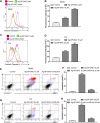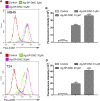Anticancer Properties and Mechanisms of Singly-Protonated Dehydronorcantharidin Silver Coordination Polymer in a Bladder Cancer Model
- PMID: 33708128
- PMCID: PMC7940527
- DOI: 10.3389/fphar.2021.618668
Anticancer Properties and Mechanisms of Singly-Protonated Dehydronorcantharidin Silver Coordination Polymer in a Bladder Cancer Model
Abstract
Bladder cancer is the most common malignant urinary system tumor. Chemotherapy is frequently used as a treatment regimen for patients with bladder cancer, however, new and effective drugs for bladder cancer need to be developed. The present study examined the effects and mechanisms of Ag-SP-DNC, a silver and singly-protonated dehydronorcantharidin complex, on bladder cancer in vitro and in vivo. It was identified that Ag-SP-DNC suppressed cell proliferation and induced apoptosis in bladder cancer cells in vitro, a suppression associated with G0/G1 phase arrest and elevated intracellular reactive oxygen species (ROS) levels. Furthermore, Ag-SP-DNC enhanced the cleaved caspase-3 levels, disrupted the mitochondrial transmembrane potential balance, and induced intracellular calcium overload. The Ag-SP-DNC-induced bladder cancer cell apoptosis was significantly decreased following treatment with a broad caspase inhibitor, zVAD-fmk. In addition, treatment of MB49 tumor-bearing mice with Ag-SP-DNC significantly inhibited tumor growth and decreased the anti-apoptosis and cell cycle promotion protein levels in the tumor. The results of the present study suggested that Ag-SP-DNC elicits a strong anticancer effect against bladder cancer, and can therefore be used as a promising treatment for bladder cancer.
Keywords: Ag-SP-DNC; apoptosis; bladder cancer; caspase-3; cell cycle.
Copyright © 2021 Zhou, Wang, Jing, Tan and Guo.
Conflict of interest statement
The authors declare that the research was conducted in the absence of any commercial or financial relationships that could be construed as a potential conflict of interest.
Figures








Similar articles
-
In vitro and in vivo anticancer effects of singly protonated dehydronorcantharidin silver coordination polymer in CT-26 murine colon carcinoma model.Bioorg Med Chem Lett. 2015 Oct 15;25(20):4477-80. doi: 10.1016/j.bmcl.2015.08.078. Epub 2015 Sep 4. Bioorg Med Chem Lett. 2015. PMID: 26346364
-
Singly protonated dehydronorcantharidin silver coordination polymer induces apoptosis of lung cancer cells via reactive oxygen species-mediated mitochondrial pathway.Eur J Med Chem. 2014 Oct 30;86:1-11. doi: 10.1016/j.ejmech.2014.08.052. Epub 2014 Aug 15. Eur J Med Chem. 2014. PMID: 25137572
-
A two-dimensional undulating Ag(I) coordination polymer constructed of Ag-C and Ag-O bonds: poly[[[μ3-(5,6-η):κO(2):κO(2)-(±)-(1S,2S,3R,4R)-3-carboxy-7-oxabicyclo[2.2.1]hept-5-ene-2-carboxylato]silver(I)] monohydrate].Acta Crystallogr C. 2011 Jul;67(Pt 7):m218-20. doi: 10.1107/S0108270111019421. Epub 2011 Jun 4. Acta Crystallogr C. 2011. PMID: 21727615
-
CDODA-Me decreases specificity protein transcription factors and induces apoptosis in bladder cancer cells through induction of reactive oxygen species.Urol Oncol. 2016 Aug;34(8):337.e11-8. doi: 10.1016/j.urolonc.2016.02.025. Epub 2016 Mar 30. Urol Oncol. 2016. PMID: 27038699
-
Natural Phytochemicals in Bladder Cancer Prevention and Therapy.Front Oncol. 2021 Apr 30;11:652033. doi: 10.3389/fonc.2021.652033. eCollection 2021. Front Oncol. 2021. PMID: 33996570 Free PMC article. Review.
Cited by
-
Antibacterial Therapy by Ag+ Ions Complexed with Titan Yellow/Congo Red and Albumin during Anticancer Therapy of Urinary Bladder Cancer.Int J Mol Sci. 2021 Dec 21;23(1):26. doi: 10.3390/ijms23010026. Int J Mol Sci. 2021. PMID: 35008445 Free PMC article.
References
LinkOut - more resources
Full Text Sources
Other Literature Sources
Research Materials

